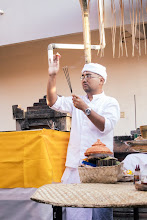
A series of ceremonies will be held in Ubud, Bali, this coming month, culminating in a unique Royal Cremation (pelebon) procession and Celebration of Life, which will take place on July 15th, 2008. This Royal Cremation Ceremony promises to be an unforgettable event for spectators.
The Ubud Royal Family will hold this ceremony for the bodies of two prominent elders of the family:
- TJOKORDA GDE AGUNG SUYASA, who was head of the Ubud Royal Family and the leader of the traditional community in Ubud since 1976, and
- TJOKORDA GEDE RAKA, who was a senior office in the police force in Denpasar until his retirement in 1992
The effigy of GUNG NIANG RAKA, whose body was cremated in a smaller ceremony in December soon after she died, will also now be given a full cremation ceremony.
The cremation procession and associated ceremonies are important rituals in the Hindu rites of passage. The bodies of the deceased will be carried through the streets of Ubud by thousands of local people on top of a nine-tiered tower called ‘bade’. The procession will be accompanied by an elaborately decorated and venerated bull effigy (Lembu) and a mythical dragon-like creature (Naga Banda), with a five meter-long tail. The naga is reserved for only the elders of the Royal family and is thus seldom seen in cremation ceremonies.
Ngaben is the principle funeral rite in Bali's Hindu society which aims to return the remains of the deceased to the elements from which all living things are created and to release the soul from all ties to this life.
Ngaben is comprised of many rituals, culminating in the burning of the corpse in an animal-shaped sarcophagus, as well as the burning of the cremation tower (bade) whose sole purpose is to transport the corpse from home to the cremation grounds.
The Ngaben is not a sad event, it can even be happy, it is a way to make the spirit of the dead happy, and to avoid disturbing him by crying. However it requires an enormous amount of time, energy, and money! All of the relatives and friends share the cost but often months, or even years, will be required to gather enough money and to make the mountains of offerings involved. One solution is for ordinary community members to join the funerals of wealthier individuals of high caste, or to organize ngaben massal (mass cremation) among the villagers, to reduce the costs.
In Ubud, such ‘mass’ cremations are held only every 3-5 years. On 15 July, 2oo8 three members of the Royal Family of Ubud will be cremated along with approximately 70 other deceased from the local community.
This ceremony is very much a public one and visitors are welcome but everyone is reminded to dress appropriately, with legs and arms covered, and to abide by any instructions and announcements.

 Close-up portraits usually have the subject's shoulders and head or less. They are basically framed around the face. These are the best to capture expressions and glamour shots. It is very important to have the light coming from a good angle for these. If you want to accent wrinkles or small details you should have the light coming from the side or from the top. If you want flattering pictures you should take these on a day that's cloudy so there is a lot of diffused light and therefore no shadows.
Close-up portraits usually have the subject's shoulders and head or less. They are basically framed around the face. These are the best to capture expressions and glamour shots. It is very important to have the light coming from a good angle for these. If you want to accent wrinkles or small details you should have the light coming from the side or from the top. If you want flattering pictures you should take these on a day that's cloudy so there is a lot of diffused light and therefore no shadows. 
 RSS Feed (xml)
RSS Feed (xml)




